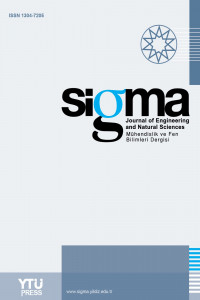CREATING THE MATHEMATICAL MODEL FOR THE SURFACE ROUGHNESS VALUES OCCURRING DURING THE TURNING OF THE AISI 1040 STEEL
Abstract
In this research, AISI 1040 steel whose hardness is 46 HRc was processed in CNC lathe. Taguchi L16 experiment design was created based on cutting speed, feed rate and depth of cut of which is consisted of four levels. As a result of these experiments, average surface roughness (Ra) values were measured. Multiple regression models for measured Ra values were created by using MINITAB 14 program. The closest results to the experiment results in regression models created for Ra were obtained with the quadratic regression model with the 99.8% coefficient of determination. With the regression models created, it was determined that the most effective parameters are the feed rate parameters. From mathematical equations created in the result of the experiments carried out, it was determined that the quadratic regression equation is approximately 90% correct.
References
- [1] Rashid W.B., Goel S., Davim J.P., Joshi S.N., (2016) Parametric design optimization of hard turning of AISI 4340 steel (69 HRC), The International Journal of Advanced Manufacturing Technology, 82(1-4), 451-462.
- [2] Gupta M., Kumar S., (2015) Investigation of surface roughness and MRR for turning of UD-GFRP using PCA and Taguchi method, Engineering Science and Technology, Engineering Science and Technology, 18(1), 70-81.
- [3] Risbood K.A., Dixit U.S., Sahasrabudhe A.D., (2003) Prediction of surface roughness and dimensional deviation by measuring cutting forces and vibrations in turning process, Journal of Materials Processing Technology,132(1), 203-214.
- [4] Tripathi D., Pradhan D., (2015) Analysis of cutting parameters for surface roughness by turning process using Taguchi method, International Journals of Advanced Manufacturing Systems, 67-73.
- [5] Ahmed G.S., Quadri S.S.H., Mohiuddin M.S., (2015) Optimization of feed and radial force in turning process by using taguchi design approach, Materials Today: Proceedings, 2(4), 3277-3285.
- [6] Dhar N. R., Kamruzzaman M., Ahmed M., (2006) Effect of minimum quantity lubrication (MQL) on tool wear and surface roughness in turning AISI-4340 steel, Journal of Materials Processing Technology, 172(2), 299-304.
- [7] Bensouilah H., Aouici H., Meddour I., Yallese M. A., Mabrouki T., Girardin F., (2016) Performance of coated and uncoated mixed ceramic tools in hard turning process, Measurement, 82, 1-18.
- [8] Rajasekaran T., Palanikumar K., Arunachalam S., (2013) Investigation on the turning parameters for surface roughness using Taguchi analysis, Procedia Engineering, 51, 781-790
- [9] Aung N.N., Zhou W., Lim L.E., (2008) Wear behaviour of AZ91D alloy at low sliding speeds, Wear, 265(5), 780-786.
- [10] Sahu S., Choudhury B.B., (2015) Optimization of surface roughness using taguchi methodology&prediction of tool wear in hard turning tools, Materials Today: Proceedings, 2(4), 2615-2623.
- [11] Pontes F.J., Paiva A.P., Balestrassi P.P., Ferreira J.R., Silva M.B., (2012) Optimization of radial basis function neural network employed for prediction of surface roughness in hard turning process using Taguchi’s orthogonal arrays, Expert Systems with Applications, 39(9), 7776-7787.
- [12] Gupta A., Singh H., Aggarwal A., (2011) Taguchi-fuzzy multi output optimization (MOO) in high speed CNC turning of AISI P-20 tool steel, Expert Systems with Applications, 38(6), 6822-6828.
- [13] Abhang L.B., Hameedullah M., (2012) Optimization of machining parameters in steel turning operation by Taguchi method, Procedia Engineering, 38, 40-48.
- [14] Kamble P. D., Waghmare A.C., Askhedkar R.D., Sahare S.B., (2015) Multi objective optimization of turning AISI 4340 steel considering spindle vibration using taguchi-fuzzy inference system, Materials Today: Proceedings, 2(4), 3318-3326.
- [15] Ramesh S., Viswanathan R., Ambika S., (2016) Measurement and optimization of surface roughness and tool wear via grey relational analysis, TOPSIS and RSA techniques, Measurement, 78, 63-72.
- [16] Mandal N., Doloi B., Mondal B., (2016) Surface roughness prediction model using zirconia toughened alumina (ZTA) turning inserts: Taguchi method and regression analysis, Journal of The Institution of Engineers (India): Series C, 97(1), 77-84.
- [17] Asiltürk İ., Akkuş H., (2011) Determining the effect of cutting parameters on surface roughness in hard turning using the Taguchi method, Measurement, 44(9), 1697-1704.
- [18] Agrawal A., Goel S., Rashid W.B., Price M., (2015) Prediction of surface roughness during hard turning of AISI 4340 steel (69 HRc), Applied Soft Computing, 30, 279-286.
- [19] Asiltürk İ., Akkuş H., Demirci M.T., (2012) Modelling of surface roughness based on vibration, acustic emission and cutting parameters with regression, Engineer & the Machinery Magazine, 632, 55-62.
- [20] Akkuş, H., Düzcükoğlu, H., Şahin, Ö. S. (2015) Investigation of bending strength with multiple regression ın aluminum honeycomb structures, Celal Bayar University Journal of Science, 11(2), 217-223.
Details
| Primary Language | English |
|---|---|
| Journal Section | Research Articles |
| Authors | |
| Publication Date | June 1, 2017 |
| Submission Date | February 6, 2017 |
| Published in Issue | Year 2017 Volume: 35 Issue: 2 |
IMPORTANT NOTE: JOURNAL SUBMISSION LINK https://eds.yildiz.edu.tr/sigma/


